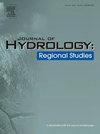Risk assessment and sources associated with potentially toxic elements in suspended particulate matter: A karst river perspective in active mining area
IF 4.7
2区 地球科学
Q1 WATER RESOURCES
引用次数: 0
Abstract
Study region
Daiyang River Basin, a typical karst river basin impacted by mining activities in Guizhou, Southwest China.
Study focus
Rivers are fundamental components of regional water security, but they are facing potentially toxic elements (PTEs) pollution caused by mining activities. This study investigated the concentration, behavior, risks and sources of nine PTEs in suspended particulate matter (SPM) from mining-impacted karst rivers, which are essential for the safety and management of karst water environments.
New hydrological insights for the region
The contents of Cr, Ni, Cu, Zn, As, Cd, Sb and Hg exceeded the corresponding local soil background values, with Zn and Cu being the most important pollutants. These elements caused a very high potential toxicity risk to the basin and unacceptable carcinogenic and non-carcinogenic risks to the local residents. Correlation analysis and the positive matrix factorization (PMF) model indicated that Ni, Cd, Zn and Cu were mainly derived from mixed sources of geological background and anthropogenic activities (30.95 %), Hg, Sb, and As were related to coal mining and combustion sources (28.91 %), while Pb, As, Cr and Sb were mainly contributed by natural sources (40.15 %). Furthermore, mixed sources, mining-related sources and As were identified as priority control factors in the study area. These insights can provide powerful support for decision-makers to develop control policies and reduce PTEs pollution in karst areas.
与悬浮颗粒物中潜在有毒元素相关的风险评估和来源:从活跃矿区的喀斯特河流角度看问题
研究重点河流是区域水安全的基本组成部分,但它们正面临着采矿活动造成的潜在有毒元素(PTEs)污染。本研究调查了受采矿活动影响的岩溶河流悬浮颗粒物 (SPM) 中九种潜在有毒元素的浓度、行为、风险和来源,这对岩溶水环境的安全和管理至关重要。这些元素对流域造成了极高的潜在毒性风险,并对当地居民造成了不可接受的致癌和非致癌风险。相关性分析和正矩阵因式分解(PMF)模型表明,镍、镉、锌和铜主要来自地质背景和人为活动的混合源(30.95%),汞、锑和砷与采煤和燃烧源有关(28.91%),而铅、砷、铬和锑则主要来自自然源(40.15%)。此外,混合源、采矿相关源和砷被确定为研究区域的优先控制因素。这些见解可为决策者制定控制政策和减少岩溶地区的 PTEs 污染提供有力支持。
本文章由计算机程序翻译,如有差异,请以英文原文为准。
求助全文
约1分钟内获得全文
求助全文
来源期刊

Journal of Hydrology-Regional Studies
Earth and Planetary Sciences-Earth and Planetary Sciences (miscellaneous)
CiteScore
6.70
自引率
8.50%
发文量
284
审稿时长
60 days
期刊介绍:
Journal of Hydrology: Regional Studies publishes original research papers enhancing the science of hydrology and aiming at region-specific problems, past and future conditions, analysis, review and solutions. The journal particularly welcomes research papers that deliver new insights into region-specific hydrological processes and responses to changing conditions, as well as contributions that incorporate interdisciplinarity and translational science.
 求助内容:
求助内容: 应助结果提醒方式:
应助结果提醒方式:


